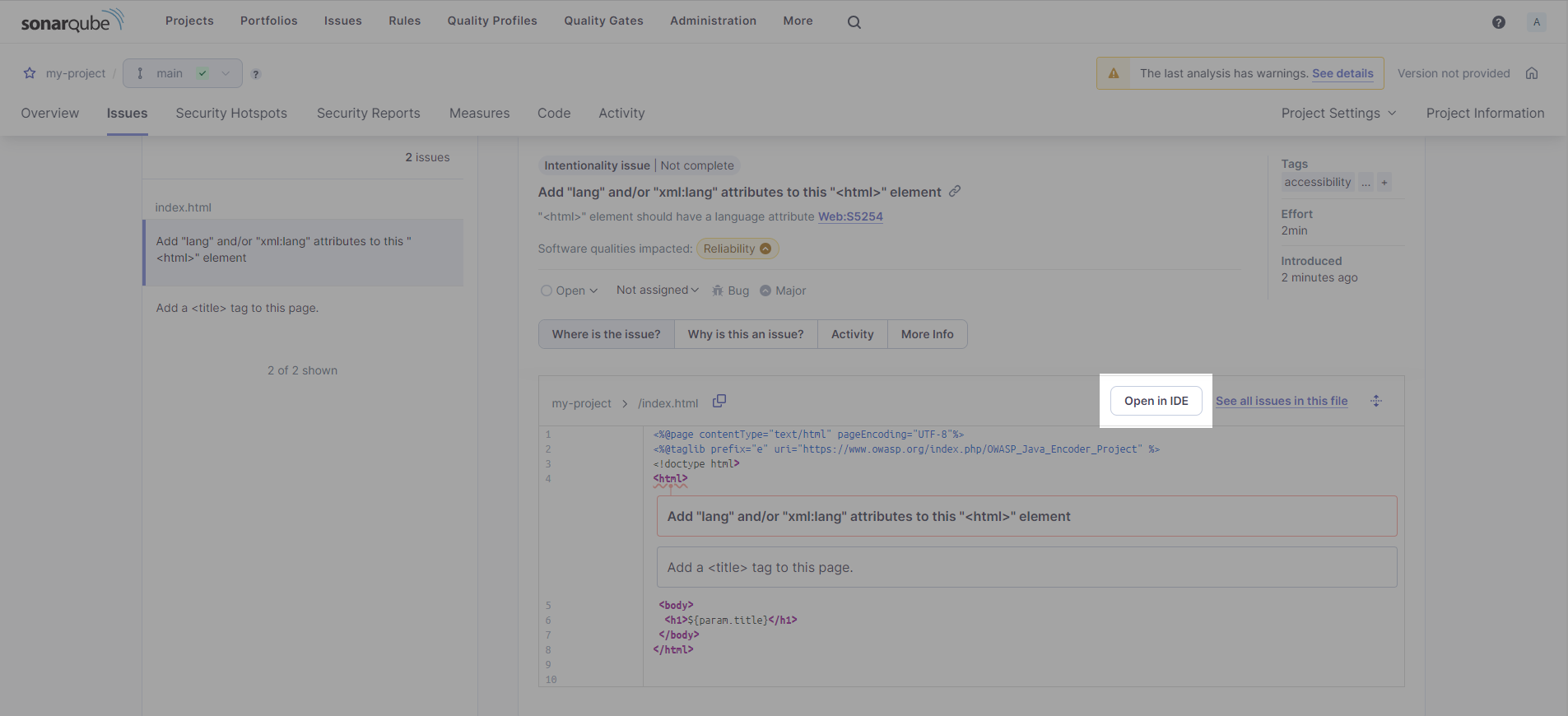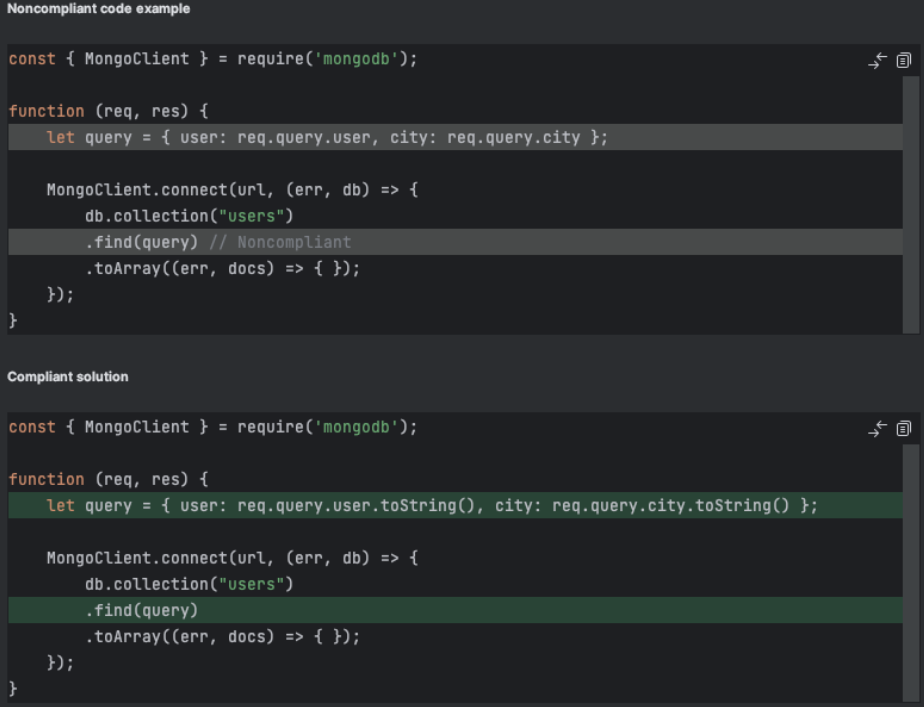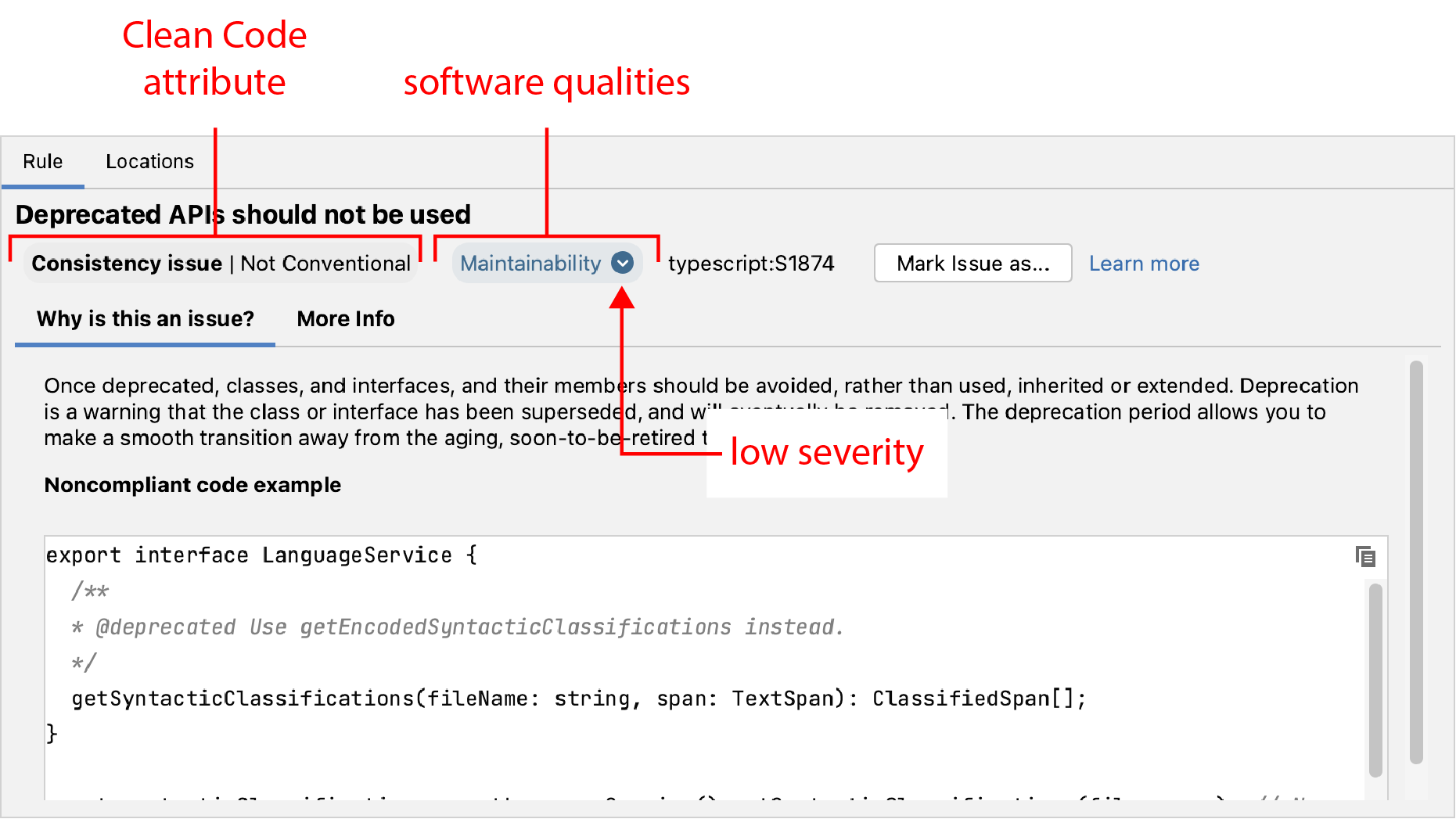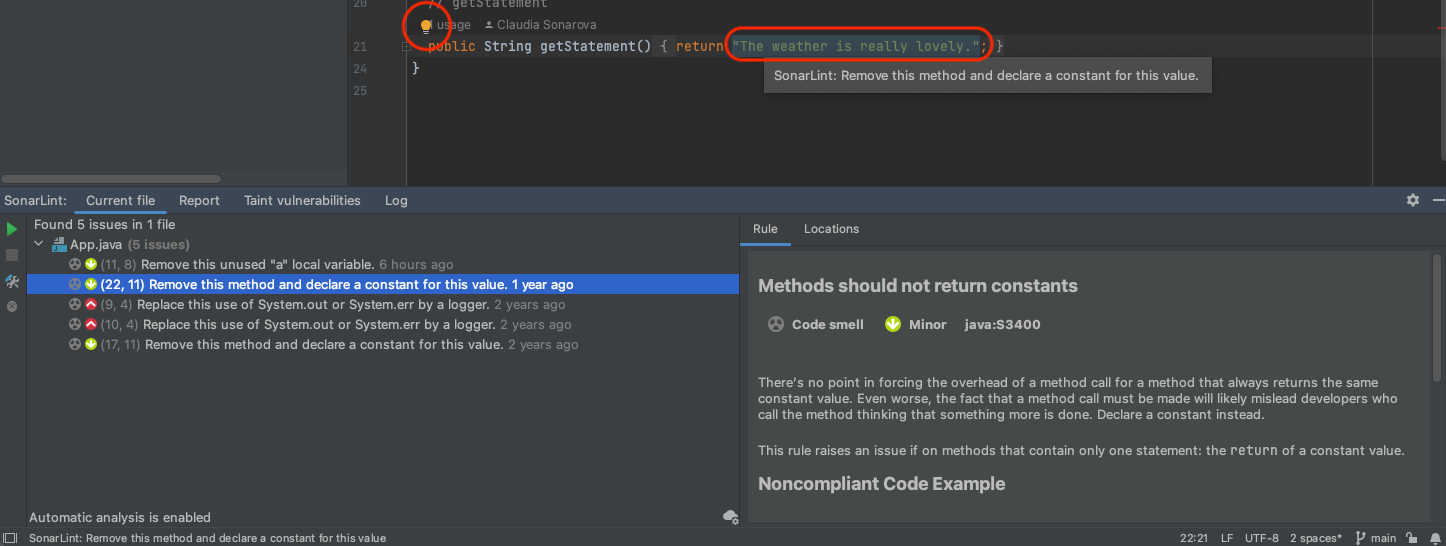Was this page helpful?
Investigating issues
SonarLint can help developers by letting them perform local analyses to check their code before pushing it back to the SCM. While running an analysis, SonarLint raises an issue every time a piece of code breaks a coding rule.
Usually, a first analysis is performed as soon as one of the supported files is opened. Then, regular analyses are triggered when the editor content changes and/or when the file is saved.
This page describes how to find and investigate issues in your IDE.
Defining issues
An Issue is a problem in your code that prevents it from being Clean Code. Issues found in code are linked to Clean Code attributes, and these attributes signify how your code will impact one or more software qualities. Software qualities determine the overall severity of an issue that feeds back into the overall status of your code when implementing a Clean as You Code methodology; please see the SonarQube or SonarCloud documentation for more about Clean as You Code.
Each issue is linked to one Clean Code attribute which is associated with one or more software qualities; each software quality has a level of severity. Please check the Clean Code benefits page on software qualities for more information.
To communicate the code attributes, software qualities, and severity of issues found in your code, SonarLint displays them in the Rule tab as described below.
Finding issues
For most issues, SonarLint provides information about why there is an issue and offers one or more actions to Fix your issue. Information is displayed in 4 places:
- In the IntelliJ Text Editor, identifiable by the classic squiggles underlining issues in the code.
- In the SonarLint view window under the Current file tab for issues found in the active file.
- In the Tooltip, you will find a recommended action(s) found by clicking on the light bulb in the left margin of the code explorer.
- In the SonarLint view window, Report tab. In the Report tab, open the collapsable file menu to view the file’s issues.
Opening issues in the IDE from SonarQube
Understanding issues in context is a helpful way to address problems more effectively. Beginning in SonarQube 10.3, it is possible to open all issues in your IDE, including taint vulnerabilities. With SonarQube 10.4, an automated Connected Mode setup feature is available.
Go to the SonarQube > Your Project > Issues page, pull up the issue’s detail view and select the Open in IDE button as an authenticated user to edit the issue in your IDE.

It’s best if your project is already open in the appropriate IDE and bound to the server using Connected mode; if not, you will be prompted to set up a new connection and/or bind your project using the automatic Connected Mode setup feature.
If you’ve already fixed the issue in your code, SonarLint will not be able to find it; only matching code will be highlighted. In this case, check that recent changes have been analyzed by SonarQube and check the documentation on SonarQube Issues for details about managing your issues on the server.
Please see the Connected Mode documentation to bind your project to an instance of SonarQube 10.3+. And if you have troubles with the automatic Connected Mode setup, we identified the most common errors for Troubleshooting Connected Mode setup.
Focusing on new code
Focusing on new code is an important part of the Clean as You Code approach, where you apply your effort and attention on submitting clean code to avoid introducing new issues. SonarLint for IntelliJ allows you to focus on new code by filtering issues shown in the IDE, as determined by your SonarQube or SonarCloud new code definition.
Setting your focus on new code has these prerequisites:
- SonarLint must be running in Connected Mode.
- Your local project must be bound to a SonarQube or SonarCloud project.
- The new code definition must be defined in SonarQube or SonarCloud using a Previous version, Number of days, or Specific analysis.
- The Reference branch new code definition is not supported. Please check the documentation in SonarQube or on SonarCloud to properly set your new code definition.
Focusing on new code is easy. After setting up Connected Mode and binding your folder to a project, use one of these 3 methods to activate the Set focus on new code feature:
- Select the target icon found in the left sidebar of the SonarLint > Current File tab.
- Select the SonarLint icon found in the upper-right corner of the IntelliJ > Editor.
- Navigate to IntelliJ > Settings > Tools > SonarLint and select Set focus on new code.
With the SonarLint focus mode deactivated, all issues found in your project will be shown in the same list.
When deciding to override a globally defined new code definition at the project level in SonarQube or SonarCloud, note that it is not possible to specify a unique new code definition at the branch level and still activate the SonarLint focus mode option.
The SonarLint tabs
The Current File tab
From the SonarLint view window, click the green arrow to analyze the active file; you will get a notice if Automatic analysis is enabled. Once the analysis is complete, select an issue from the list and review the Rule description in the right panel; a noncompliant and compliant code example will be presented for most rule violations. Some rule descriptions provide external links for more information.
The Locations tab gives you a list of locations where this issue is repeated within the current file; a list of corresponding numbers will appear next to your code in the Explorer to correlate the location report with the location in the current file. Double-clicking on the issue in this tab highlights the applicable code line in the explorer.
Hover over the highlighted code in the explorer to reveal one or more recommended actions.
Reports about secondary locations, even those issues occurring in multiple files, only include locations found in the current file. Similarly, locations found under the Report > Locations tab are locations found within the selected file, not locations found between all files.
The Report tab
Issues listed in the Report tab are displayed in a collapsable tree menu and present information regarding the Rule and the issue’s Locations in the same way as in the Current file tab. Information found in the Report > Locations tab about secondary locations are locations found within the selected file, not between all files.
The Rule tab
Simply select an issue in the SonarLint view or choose SonarLint: Show rule description from the tooltip to open the Rule tab. Here, you will find a brief explanation of the rule as well as Noncompliant and Compliant code samples.

SonarLint for IntelliJ supports syntax highlighting. In addition, users are able to visualize a diff view for the non & compliant code samples which should help you fix your issue. Note that diff highlighting is only available for rules descriptions migrated to the new format, and we're progressively migrating all existing rules to the new format.
An issue’s Clean Code attribute, software qualities, and severity are presented to you when opening the SonarLint > Rule tab. Below the rule title, you will find the Clean Code issue badges that highlight an Issue’s Clean Code classification.

Check the Clean Code definition page for details about Clean Code attributes, and the Clean Code benefits page to better understand software qualities for more details about how they help classify your issue.
Be sure to check out the Clean Code definition page for more details about Clean Code attributes and how they help classify your issue.
At the tooltip
When an issue is selected in the Current File or Report tabs and visible in the Explorer window, you can click the light bulb or hover over the highlighted code to reveal a tooltip description with one or more recommended actions.

As a rule of thumb, most actions provided by SonarLint are prefixed with the tag "SonarLint" to distinguish them from actions offered by the IDE.
